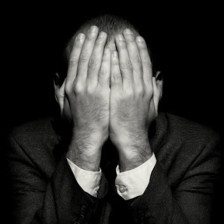
Intrigued by a scene of Tom Cruise disfigured after a car accident, I paid $2.99 to rent Vanilla Sky on Amazon Prime.
In the movie, Tom Cruise portrays a rich entitled playboy who inherited his father’s multi-million dollar business and is disfigured in a car accident.
Because his top-notch team of surgeons cannot reconstruct his face he is provided with a “facial prosthesis” (i.e a mask) to wear while he learns to accept his new appearance.
I could relate, after my facial laceration, I wore a facial prosthesis in the form of a bandaid for several weeks.
I would hesitate to pull it off, and when I had it on my cheek I felt protected and safe.
From this standpoint it made sense, but the reaction of course to Tom and his mask is understandable.
Expressionless, yet flawless, the mask does very little except protect his ego
And sure enough, when Tom removes it, he is on the receiving end of taunts, pity, and free shots of tequila.
It doesn’t help that the disfigurement turns him into an A+ rated ass-hole.
It isn’t the scar that makes him mean, angry and hateful. It is his reaction to his circumstances.
Regardless, I wanted so much to have a facial prosthesis.
As the movie progresses Tom discovers that his team of surgeons has a new incredible procedure that will render him scar-free.
He takes the “purple pill” and awakes perfectly reconstructed… He has a lot of wonderful sex with his partner “Sofia” played by Penelope Cruz. His life becomes full again, he is happy, he is with friends, he is out and about. He receives the respect and envy of his colleagues.
I won’t give away the ending, but the movie makes a point… Disfigured, Tom’s life is a living hell, yet when the scars are gone his life is complete.
This is the fear many of us suffer with every day as we awake to our BDD

There is a bathroom scene in the movie that I live every day. After my injury I would wake at night, turn on the light and pray that it was all a bad dream. Which of course it was not… Unlike Tom in Vanilla Sky, I have to find a way to live, make a life with my disfigurement.
With my BDD this is so much harder because now I do have something to obsess about, to identify as the root cause of my pain and suffering and social anxiety.
For a large part of the movie, I was hoping that the medical team had played a mind trick on Tom, convincing him that he wasn’t actually scarred, hacking his mirrors, and showing that disfigurement is all in the mind. Proving, once and for all, that how we perceive our face matters more than what we actually look like.
This would have been a better take-home message from the movie.
But Vanilla Sky falls short in this regard, and although it is a thoughtful critique, the movie simply reinforces many of the stereotypes that make me want a facial prosthesis in the first place.
